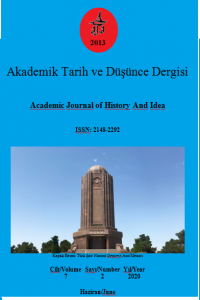Hititçe Çiviyazılı Belgelerde Geçen (GIŠ)zau-: “Bir Kült Nesnesi” Kelimesi Üzerine Bazı Gözlemler
Hitit metinleri, kutlanan bayramlar ve gerçekleştirilen ritüeller hakkında ayrıntılı bilgiler aktarmaktadır. Bu bayram ritüellerinde kullanılan nesnelerin arasında (GIŠ)zau- da yer almaktadır. (GIŠ)zau-, gümüş, altın ve ağaçtan yapılmış bir kült nesnesi olarak úda-: "getirmek"; da- "almak"; dai-: "koymak"; har(a)k-: "tutmak"; peda-: "taşımak, alıp götürmek" fiilleri ve NINDA.GUR4.RA, NINDAmuriyala, NINDAhali, NINDAharši ekmekleri ile birlikte geçmektedir. GAL (LÚ.MEŠ)MEŠEDI, LÚSANGA, UGULA LÚMEŠ GIŠBANŠUR ve LÚhamina-görevlileri tarafından kullanılan/taşınan (GIŠ)zau-, bayram töreni ritüellerinde "kutsal bir nesne" olarak "ekmeğin üzerine/yanına konulmakta" ve ekmek gibi "kutsal" kabul edildiği anlaşılmaktadır. Araştırmamızda söz konusu kelimenin geçtiği Hitit çiviyazılı belgeler incelenerek (GIŠ)zau- hakkında bazı yorum ve tespitlere yer verilmiştir. Geçtiği bayram ritüellerinin Hatti-Hitit kültü ve dinsel gelenekleri içerisinde olduğu dikkate alındığında kelimenin Hattice kökenli olabileceği değerlendirilmektedir.
Anahtar Kelimeler:
(GIŠ)zau-, Bayram ritüelleri, Dini bir sembol, Ekmek
Some Observations on the Word (GIŠ)zau-: "An Object of Cult" in Hittite Cuneiform Documents
Hittite texts convey detailed information about
celebrations and rituals performed by the Hittite society. (GIŠ)zau- is among the objects used in these
rituals. (GIŠ)zau-,
as a cult object made of silver, gold and wood, occurs together with the verbs úda-: "to bring"; da-: "to take"; dai-:
"to put"; har(a)k-:
hold, peda-: "carry" and
with breads of NINDA.GUR4.RA, NINDAmuriyala, NINDAhali,
NINDAharši. (GIŠ)zau-, used/carried by GAL (LÚ.MEŠ)MEŠEDI, LÚSANGA, UGULA LÚMEŠ
GIŠBANŠUR and LÚhamina-
was put on/near bread as a holy object in the feast rituals and accepted “holy” like bread. This paper
examines the mentioned word attested in Hittite cuneiform documents and focuses
on some comments and observations about (GIŠ)zau-. It is evaluated that the root of this word can be found in
the Hattic language, since the feast rituals related to (GIŠ)zau- belonged to Hattic-Hittite cult and
religious traditions.
Keywords:
(GIŠ)zau-, Feast rituals, A religious symbol, Bread,
___
- GÜTERBOCK, H.G., HOFFNER, H.A. ve van den HOUT, T.P.J. The Hittite Dictionary of the Oriental Institute of the University of Chicago, Volume Š, Fascicle 1, Chicago: The Oriental Institute, 2002.
- GÜTERBOCK, H.G., HOFFNER, H.A. ve van den HOUT, T.P.J. The Hittite Dictionary of the Oriental Institute of the University of Chicago, Volume Š, Fascicle 3, Chicago: The Oriental Institute, 2013.
- HAAS, V., Geschichte der hethitischen Religion, Handbuch der Orientalistik, Leiden: Brill, 1994.
- HOFFNER, H.A. ve MELCHERT, H.C., A Grammar of the Hittite Language. Part 1: Reference Grammar; Part 2: Tutorial, Indiana: Eisenbrauns, 2008.
- KLOEKHORST, A., Etymological Dictionary of the Hittite Inherited Lexicon, Leiden: Brill, 2008.
- LAROCHE, E., Dictionnaire de la langue louvite, Paris: Librairie Adrien Maisonneuve, 1959.
- MELCHERT, H.C., Cuneiform Luvian Lexicon, Chapel Hill: NC, 1993.
- NAKAMURA, M., Das hethitische nuntarriyašha-Fest, Uitgaven van het Nederlands Historisch-archaeologisch Instituut te Istanbul/Publications de l'Institut Historique-Archéologique Néederlandais de Stamboul, Leiden: Nederlands Instituut voor het Nabije Oosten, 2002.
- NEU, E. Interpretation der hethitischen mediopassiven Verbalformen, Studien zu den Boğazköy-Texten 5, Wiesbaden: Harrassowitz, 1968.
- POPKO, M., Review: Jakob-Rost L., Keilschrifturkunden aus Boghazköi 59 Hethitische Rituale und Festbeschreibungen, KUB 59, Berlin, 1989, Orientalia. Commentarii periodici Pontificii Instituti Biblici. Nova Series 60, (1991): 124-127.
- POPKO, M., Zippalanda. Ein Kultzentrum im hethitischen Kleinasien, Texte der Hethiter 21, Heidelberg: Universitätsverlag C.Winter, 1994.
- POPKO, M., Arinna. Eine heilige Stadt der Hethiter, Studien zu den Boğazköy-Texten 50, Wiesbaden: Harrassowitz, 2009.
- Yayın Aralığı: Yılda 6 Sayı
- Başlangıç: 2013
- Yayıncı: Hakan YILMAZ
Sayıdaki Diğer Makaleler
Şeyh Seyyîd Abdülkâdir-i Belhi’nin Hayatı, Edebî Kişiliği ve Eserleri
Male Sınıfı İnsansız Hava Aracı (İHA) Teknolojisi ve Konvansiyonel (geleneksel) Savaştaki Yeri
Batı’ya Yön Veren Metinler (4 Cilt)
Cengiz Aytmatov’un Beyaz Gemi Romanında Halk Edebiyatı Motifleri
Namık Kemal’in Eski Türk Edebiyatına Eleştirileri
Van Milletvekili İbrahim Arvas’ın Biyografisi ve Türkiye Büyük Millet Meclisi’ndeki Faaliyetleri
Eski Mezopotamya’da Başörtüsü Kullanımı Üzerine
Sevinç Çokum’un “Ağustos Başağı” Adlı Romanında Deyimler, Atasözleri ve Aforizmalar
